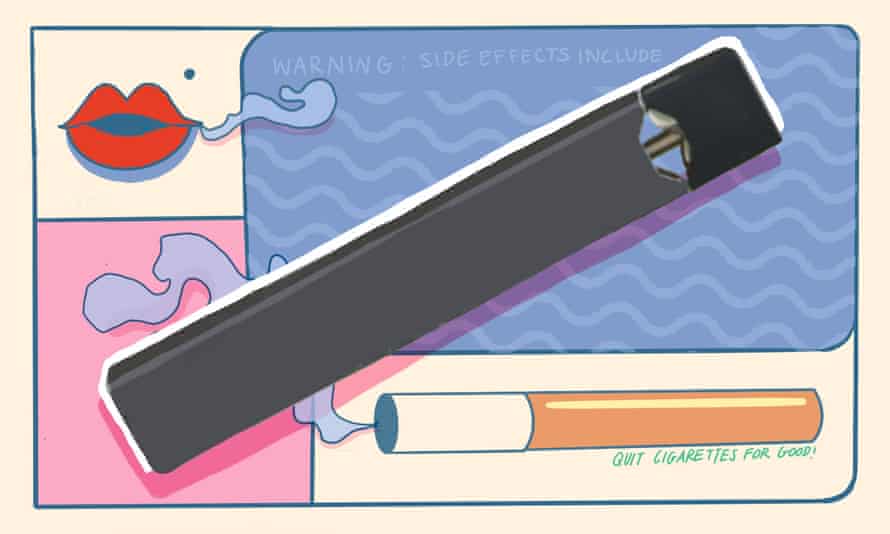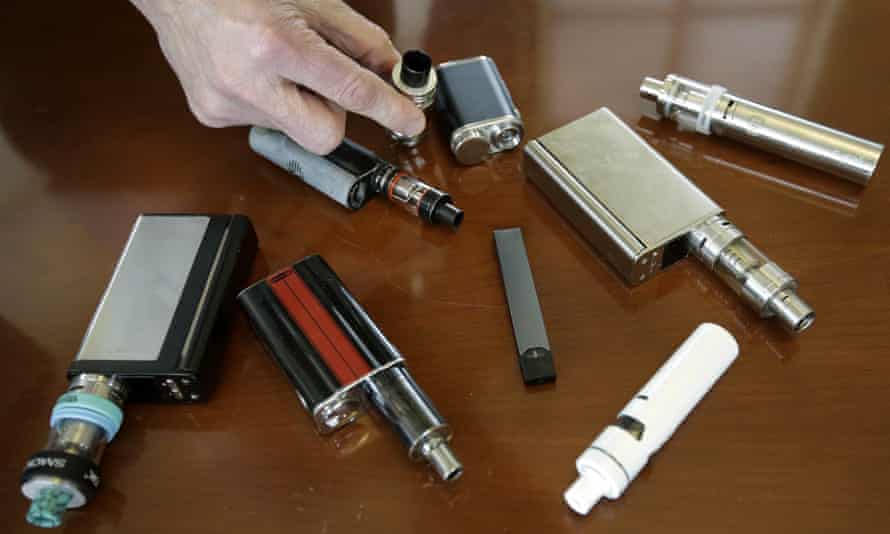The company has been shamed by health regulators, lost revenue and is the center of hundreds of US lawsuits. Now it has thrown in a last-ditch effort to continue sales

Wudan Yan
Thu 2 Sep 2021
More than a decade ago, Adam Bowen and James Monsees became friends over their smoke breaks at Stanford University. They were graduate students when they first conceived of the idea behind Juul: conventional cigarettes, like the ones they couldn’t stop smoking, were bad not because of nicotine, but for all the other chemicals from burnt tar.
The pair had a vision: design a device that would deliver solely nicotine, offer a better experience for smokers and help those who wanted to quit cigarettes.

The great vape debate: are e-cigarettes saving smokers or creating new addicts?
That idea has morphed into Juul, the leading e-cigarette company, which some have accused of hooking teenagers on nicotine.
A sizable number of young people who developed a vaping habit after using Juul have then sought out cheaper, alternative products to satisfy their fix: black market pods laced with vitamin-E acetate and other toxins that have led to more than 2,800 counts of lung injury in the US and two of its territories. According to the Centers for Disease Control and Prevention (CDC), 68 deaths in the US have been confirmed to be linked to those black market pods.
Now, Juul is at the center of a string of lawsuits for knowingly addicting a generation.
Juul has faced heavy criticism for its initial botched marketing to teens – they offered flavors like mint, mango and creme brulee, all of which tantalized teens up until 2018, when they removed flavors from stores, and fall 2019, when they took them offline. Yet some research suggests that for adult smokers, Juul and similar products might be some of the best tools out there to quit smoking.
Now that Juul has been publicly shamed, disciplined by health regulators, lost significant revenue, and is the center of hundreds of lawsuits in the US related to teen use of their devices, the company has thrown in a last ditch effort to stay on the market: they’ve appealed to the US Food and Drug Administration (FDA) to allow them to continue their sales.
If the FDA rejects the appeal, Juul is given the boot. But if its application is approved, can Juul revive its image, regain public trust and position itself as a public health boon?
With half a million smokers still dying every year from illnesses caused by or related to smoking, it’s vital to find better ways to get people off cigarettes altogether, says Nancy Rigotti, the director of Massachusetts general hospital’s Tobacco Research and Treatment Center in Boston. Smoking cessation tools such as nicotine gum or patches are generally ineffective, as many smokers relapse, she says, which means alternatives are needed.
When e-cigarettes first hit the market, public health researchers were intrigued to see whether they could help smokers quit. Smokers would still get the hand-to-mouth movement with the device, inhale as they would normally, and get a hit of nicotine at the back of their throat.

“Anecdotally, e-cigarette users have said that they have used [e-cigarettes] to quit smoking,” says Alison Breland, who co-leads the Center for the Study of Tobacco Products, a research program at Virginia Commonwealth University in Richmond.
That’s because e-cigarettes contain more nicotine than conventional cigarettes – they contain about 12mg each – which helps users satisfy their addiction.
By comparison, patches vary in strength, from 7-22mg a patch, but needs to get through human skin in order to have an effect. And nicotine gum leads to markedly lower levels of blood nicotine compared with smoking a cigarette.
Small studies in recent years show that if there’s more nicotine in the e-cigarette, more ends up in your blood. E-cigarettes are therefore more effective than gum and patches because of that additional nicotine – it eases withdrawal symptoms, and could possibly help people get off cigarettes – although the jury’s still out if they can get people off nicotine altogether.
In the UK, the government has gone as far as to launch a public health campaign that “show middle-aged men with beards vaping”, Bauld says. E-cigarettes are largely seen as a public health good in the country – they are even sold in pharmacies appended to hospitals – because they are viewed as a medical intervention for smoking cessation.
One study published in 2019 in the New England Journal of Medicine showed that adult British smokers were twice as likely to quit cigarettes if they switched over to e-cigarettes, compared with smokers who switched to the patch or gum. (Breland’s excitement over the results is tempered, however, as it was only an 18% quit rate for people who used e-cigarettes in the trial and received intensive counseling, compared with 9% using gums and patches.)
Meanwhile, the explosion of e-cigarettes in the US, which has mostly been led by Juul, was largely due to its early marketing and advertising efforts that made using the e-cigarettes look cool.
Within the first six months Juul was on the market, the company purchased advertisement space on Nickelodeon, the Cartoon Network and teen magazines. In magazines, readers would find girls wearing high ponytails and crop tops holding a Juul. Other advertisements enticed readers to join JUUL’s launch parties, showing blonde girls donning distressed denim jeans while casually holding a JUUL.
Given the potential that e-cigarettes could have, there may be lessons for the regulators in the US and Juul to keep in mind moving forward.
Dorian Fuhrman, the founder of the advocacy group Parents against Vaping, knows the struggle of teens getting hooked onto Juul all too well.
Her son, Phillip, got introduced to Juul in 2017 at age 14 when a friend handed him a device. He had never used nicotine before. At first, he and his friends vaped Juul’s mint pods. Fuhrman isn’t sure how much her son vaped, but she knows he felt the cumulative effects of it when he tried out for the basketball team and had trouble breathing.
Over the years, Fuhrman has watched her son become moody and volatile during periods of withdrawal. When he tried to quit, his doctor recommended the patch and nicotine gum – which both worked only in the short term. He has also tried to go cold turkey, but has fallen back on Juul during times of stress, Fuhrman says.
Before spring 2018, when e-cigarette growth was still unchecked by regulators, Juul even went as far as to send representatives to schools, including the one that Fuhrman’s son attended. The representatives claimed – without evidence – that Juuls were safer than traditional cigarettes, describing Juuls as the “iPhone of e-cigarettes” to the students.
“When we heard that, we were just horrified,” Fuhrman says. That was the moment she decided to start Parents Against Vaping.
“They really went wrong with the marketing to children,” says Breland. “The aggressive marketing, marketing in schools, all the flavors – that’s their downfall. I don’t know how they’d recover from that.”

Even though the company has taken flavored pods off the market as part of their “reset”, leaving only menthol and Virginia tobacco on the market, Fuhrman’s son has switched to menthol and flavored disposable e-cigarettes manufactured by brands other than Juul.
“It’s classic: kids will just go to what’s left on the market,” Fuhrman says. “You can’t leave any flavor on the market; kids will gravitate towards that flavor.”
In other words, for Juul to be a public health good, it won’t just be a matter of regulating JUUL – but all other e-cigarette products.
After the FDA disciplined Juul in 2018 for the ads and marketing to teens, some employees still believed that they were working towards making a good smoking cessation product and were trying to avoid getting nonsmokers hooked on Juul. The company website has since built an entire section of its webpage that lists the measures they are taking to prevent Juul from getting into the hands of teens.
One former Juul employee hired in 2018 told me that during his orientation at the company, new employees were told, “If you don’t smoke, please don’t start using the product,” since any product containing nicotine can become addictive. Another employee in late 2019 said that Juuls helped him get off conventional cigarettes, and that he hadn’t touched one since he began work at Juul.
During his tenure there, the former employee thought most of his colleagues believed Juul was being misrepresented by the media. “The narrative around the company had gotten so negative that it was almost ridiculous, even though internally we felt like we were doing all we could to mitigate the situation. No one really wanted teenagers to be using the product,” he says. (This employee asked to be kept anonymous for fear of retribution, as he signed a nondisclosure agreement with Juul.)
That year, after intense pressure from regulators, Juul removed flavored pods from stores and put them only on their website, where customers had to pass the 21-age requirement to buy them. A year later, JUUL decided to pull those flavors from their website, leading to a further decrease in the company’s revenue.
Last summer, Juul, along with hundreds of other e-cigarette companies, submitted its pre-market tobacco applications to the FDA. These applications are meant for new e-cigarette or tobacco products to prove that they are a public health good.
FDA approval of these applications means that the agency has deemed that the public health good of a product outweighs the possible risks. A company spokesperson for Juul told the Guardian that their impetus for seeking FDA approval was to become a “science- and evidence-based company, engage in open and transparent dialogue with our stakeholders, and take methodical and responsible actions to advance the potential for harm reduction for adult smokers while combating underage usage”.
KC Crosthwaite, Juul’s current CEO, said in a statement last year: “I’m fully aware that building a risk-proportionate regulatory framework will take time. Yet I am ultimately optimistic about the future.” (Bowen and Monsees, the original cofounders, have stepped down after acknowledging that the company had made missteps.)
Even though the application is not public and can’t be shared via public records request, some of the studies the company submitted as part of the application appeared in the May/June issue of the American Journal of Health Behavior. According to the New York Times, Juul paid the journal $51,000 for the special issue.
The studies largely focused on adult usage and switch rates, rather than outcomes tied to teen use of their product. Over the year, Juul’s studies showed that adults who used Juul reduced conventional cigarette consumption by more than 50% – all the while switching over to Juul. The one paper that focused on underage use suggested that Bluetooth technology can help verify the user’s age to curb teenage sales.
Fuhrman, the anti-vaping advocacy group founder, is adamant that “no e-cigarette is a public health good for teens”, citing studies that show teenagers who start on devices like Juul will later move on to combustible cigarettes. Her fear is that the FDA will approve any flavored or menthol flavored e-cigarettes, including Juul – a single loophole could continue addicting teenagers, she says.
Like any new technology, it’s just too early to say what the long-term impact of e-cigarettes will be. It took decades for public health officials to declare that conventional cigarettes were a hazard. For smoking, for instance, individuals will have quit if they have gone seven years without a cigarette, explains David Gortler, former senior adviser to the FDA commissioner on policy and drug safety. Simply put, not enough time has passed to suggest that vaping is safer than burning tobacco, Gortler says.
For now, however, Juul’s future in the US is in the hands of the FDA, which has a near-impossible task to balance the impact that Juul has had on underage nicotine use with the hopeful benefits of harm reduction from cigarettes, with data that we currently do not have.
Misinformation on Twitter adversely affects adults’ health decisions
A new study is the first to explore the effect of misinformation on Twitter about e-cigarette harms.
Video: https://youtu.be/fsS6FVq3jd4
UK and US adult smokers who were considering using e-cigarettes were deterred when exposed to tweets falsely implying the devices are more harmful than conventional cigarettes, finds new research. The study, published in BMJ Open and led by researchers at the University of Bristol (UK) and the University of Pennsylvania (US), is the first to examine the effect of this type of exposure which has important implications for public health.
While existing studies have examined current perceptions of e-cigarette harms, little is known about the role of exposure to misinformation on social media on these perceptions, and consequently on e-cigarette intentions and use.
In this Cancer Research UK (CRUK)- funded study, researchers from Bristol’s medical school and Penn’s Annenberg School for Communication recruited 2,400 adult smokers from the US and UK who were not currently using e-cigarettes to take part in an online randomized controlled experiment to assess the effect of exposure to misinformation about e-cigarette harms on Twitter on adult current smokers’ intention to quit smoking cigarettes. They also assessed their intention to purchase e-cigarettes and their perceived relative harm of e-cigarettes compared to regular cigarettes.
Participants were shown different types of health-related information and asked for their opinions about e-cigarettes, and were asked questions on their intention to quit smoking, intention to purchase e-cigarettes, and perceived relative harm of e-cigarettes compared to regular cigarettes. After randomization, they were asked to view one tweet at a time in random order (four tweets in total) and were asked brief questions about each tweet, in terms of the perceived effectiveness of the tweet; likelihood of replying, retweeting, liking, and sharing the tweet; and their emotional response to the tweet.
Results showed that US and UK adult current smokers were deterred from considering using e-cigarettes even after brief exposure to tweets that e-cigarettes are as or more harmful than smoking, suggesting that misinformation about e-cigarette harms may adversely influence adult smokers’ decisions to consider using e-cigarettes as a way of stopping smoking. Conversely, the results found that US adult current smokers may be encouraged to use e-cigarettes and view them as less harmful than regular cigarettes, after exposure to tweets that e-cigarettes are completely harmless.
Andy Tan, Associate Professor at the University of Pennsylvania’s Annenberg School for Communication and Director of the Health Communication & Equity Lab, explains: “This is the first study to explore the effect of exposure to misinformation about e-cigarette harms on Twitter among smokers. These findings are important because they show that even brief exposure to misinformation about e-cigarettes may be hindering efforts to reduce the burden of tobacco smoking on current smokers in the US and UK.”
Dr. Caroline Wright, Senior Research Associate and CRUK Population Research Postdoctoral Fellow from Bristol Medical School and the study’s lead author, said: “Health information is commonly accessed online, with recent reports showing around 63 percent of UK adults using the internet to look for health-related information, and 75 percent of US adults using the internet as their first source of health information. People are increasingly encountering free and publicly available health information through social media platforms such as Twitter or Facebook. However, this ease of accessing information comes at a cost as the spread of misinformation can have negative consequences on people’s health choices and behaviour. Given this, we would remind smokers that although e-cigarettes are not completely harmless, their short-term health risks are considerably lower than smoking regular cigarettes. We would encourage smokers accessing information online to check their national health agency for accurate information about e-cigarettes.
“For health care providers we recommend being aware that your patients may have been influenced by misinformation on social media, and therefore may have misperceptions about e-cigarettes. Correct misperceptions, and consider the ways you can support your patients, so they are able to identify accurate health information. And finally, for policy makers: ensure that all social media searches associated with e-cigarettes are flagged with official health guidance, regulate all forms of misinformation on social media, and improve population awareness and skills to seek out accurate information.”
The study is funded by a Cancer Policy Research Centre Innovation grant and Cancer Research UK (CRUK).
Paper
‘Effects of brief exposure to misinformation about e-cigarette harms on twitter: a randomised controlled experiment’ by Wright C, Williams P, Elizarova O, et al in BMJ Open 2021;0:e045445. doi:10.1136/ bmjopen-2020-045445
JOURNAL
BMJ Open
METHOD OF RESEARCH
Experimental study
SUBJECT OF RESEARCH
People
ARTICLE TITLE
Effects of brief exposure to misinformation about e-cigarette harms on twitter: a randomised controlled experiment
ARTICLE PUBLICATION DATE
1-Sep-2021
No comments:
Post a Comment